Raphael Tuck & Sons
(Printed with permission from the author, Ann Montanaro)
This article is based on a paper presented in September, 2005 at The Movable Book Society
Conference in San Diego, California. It was printed in Movable Stationery, Volume 13, Number 2,
May, 2005. We have added some extra images and updated text. Updated text by vintagepopupbooks is indicated in italics and
not part of the original article.
We highly recommend a subscription to Movable Stationary. See movablebooksociety.org for more info. A bio of the author, Ann Montanaro is included at the end of this article.
Since the movable books produced by Raphael Tuck & Sons represent a very small segment of the vast printing output of the company, it is useful to have understanding of the variety of work they produced in order to put their movable books into perspective. The primary source of the biographical information about the Tuck family and history of the company came from The Romance of the House of Raphael Tuck & Sons Ltd, published in 1966, on the occasion of the company’s 100th anniversary.
Dating Raphael Tuck Information van be found in the book "Collector's Guide to Raphael Tuck and Sons: Paper Dolls, Paper Toys and Children's Books"Whitton, Blair Published by Hobby House Press, 1991 on page 6.
We would like to add that items containing the words "The World's Art Service " were likely printed after 1921.
reference: British and Colonial Printer and Stationer, 1922 page 296 states that "The very extensive range of...which Raphael Tuck and Sons are putting on the market this year under the title of " The World's Art Service " show that the firm is not resting on its laurels."
Raphael Tuck was born in 1821 in Tischl, Breslau, -in Koschmin in the German province of Poznan which is about 200 miles west of Warsaw, would later become part of Poland
He worked as a carpenter and, at age twenty-seven, married Ernestine Lissner. To improve their opportunity to increase theirincome, the Tucks moved to Breslau. The family grew and by the early l860s they had seven children, four sonsand three daughters. Their lives were disrupted by the Prusso-Danish and Austrian War (1864-1866) and the decision was made to move again. Raphael went to London in 1865 and found work and housing; his familysoon followed. Within a year or two after arriving in London, Raphael and Ernestine opened a small shop where they sold prints and frames. The shop flourished and the business expanded rapidly. Ernestine proved to be a good business woman, an organizer by nature, and a perfect administrator. Raphael was very creative, skilled technically, and also a perfectionist. In 1869 they moved to larger premises and sons Herman, Adolph, and Gustave joined the business. In addition to the selling and framing of pictures, they entered the field of publishing, producing black and white lithographs, oleographs, and chromolithographs. Special attention was paid to color reproductions.
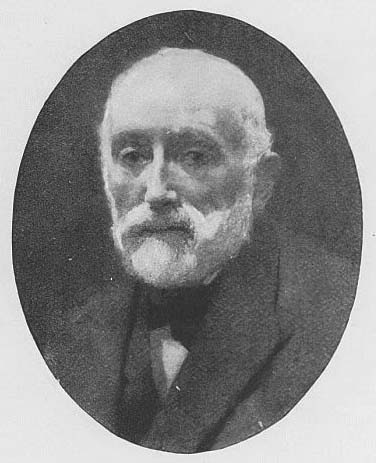 Image of Raphael Tuck ( Public domain, via Wikimedia Commons ) Image of Raphael Tuck ( Public domain, via Wikimedia Commons )
By 1870, the contribution of the three sons to the business success was obvious. Adolph, who worked directly with his father, had the same business instinct and strived for the same level of perfection. In the official company history it is noted that Gustave and Herman were salesman, encouraged by their mother who, at the end of the day would have them “compare notes, and the one who had achieved the best sales would have the biggest egg for breakfast the next morning!” In a print ad from the 1870s, the company promotes their specialization in “Oleography, chromos, prints, and coloured scraps in sheets and relief. Christmas and New Year cards, birthday, wedding and text cards.”
A brief discussion of 19th century printing may help contribute to an understanding of the influence of Raphael Tuck & Sons as a publisher. The company listed “chromos” or chromolithographed pictures as one of their specialities. It is the process of chromolithography that resulted in the beautiful books, cards, and prints produced in the mid-19th century. A chromolithograph is a color lithograph. Lithography was invented in at the end of the 18th century and originally it was a printing process achieved by etching an image into stone with nitric acid to
create either slightly elevated or slightly depressed image areas. Eventually, as workers began to fully understand the chemical nature of the process, designs were drawn or painted with greasy inks onto water-absorbing limestone. The non-image areas were treated with gum arabic and were well moistened with water, after which ink was applied with a roller. The oily ink adhered only to the greasy image area and was repelled by the water-saturated, non-image area. The image was then printed with a special press in which a scraper bar was drawn across a sheet of paper laid over the inked-up stone. Lithographic stones were heavy, cumbersome, difficult to register, and subject to breakage. Lithographs were printed in one color, usually black, and any color was added to the print by hand.
Chromolithography is a color process in which each of many colors are printed by separate stones. This requires both a number of stones and a very precise method of placing the stones so that each color is properly applied over the previous color. To be a classified a chromolithograph at least three stones have to be used but sometimes as many as fifteen were used. In the 19th century the Germans developed the most sophisticated printing processes using chromolithography. The far less costly advances of photomechanical methods made chromolithography all but obsolete by the turn of the 20th century. Yet, no other technique has come close to capturing the deep and rich oil based colors of the original chomolithographs. It is interesting to note that both paper embossing and die-cutting, used extensively by Tuck, were also mid-19th century inventions.
Greeting cards -
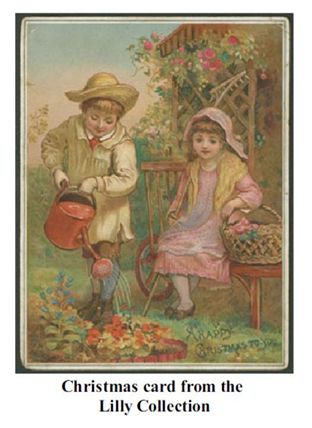
Cards of all kinds were an important part of Tuck’s business. Christmas
cards were particularly successful: The first of them was issued in 1871
and their popularity increased every year. Adolph Tuck was very
influential in promoting this side of the business. He was described as
having a “dynamic personality, possessing both a business and creative
genius supported by untiring energy.” He was a firm believer in
enterprise, new ideas, and advancement. In 1880 he took a step that was
to mark the beginning of Christmas cards as a British custom. Adolph
offered prizes worth a total of 500 guineas (estimated to be more than
$10,000 today) for new Christmas cards designs. Five thousand designs
were submitted and they were judged by members of the Royal Academy. An
exhibition was held in London and newspapers around the world reported
the enormous success. The Saturday Review, reporting on the exhibition,
said that “Mr. Raphael Tuck awoke to find himself famous.” This
pioneering event marked the turning point of Christmas cards being the
accepted wayof expressing sentiment and goodwill at Christmas time.
Christmas cards were in common use thereafter and it is reported that in
1910 Tuck had over 4,000 card designs.
Many of the Christmas cards from the late 19th century did not feature the art work usually associated with contemporary Christmas cards. Examples of Christmas cards from the 1880s and 1890s, such as the one pictured above, can be found in the Lilly Library collection at Indiana University. (http://www.indiana.edu/~liblilly/xmas2/tuck/index.html)
In 1881, at age 60, Raphael Tuck retired from the business. A partnership had been created with sons Adolph, Herman, and Gustave who were determined to carry on and expand the business. Adolph Tuck, who led the company after his father’s retirement, was constantly looking for new artists and new ideas. In 1895, he again offered prizes, this time especially for amateur writers and painters. There were more than 4,000 prizes in money and “judges’ diplomas” for the winners in the different groups, including a children’s group. Members of the Royal Academy were again the judges and there were about 10,000 contributions and 2,500 of the entries were exhibited in the Galleries of the Royal Institute of Painters in Water Colours in London.
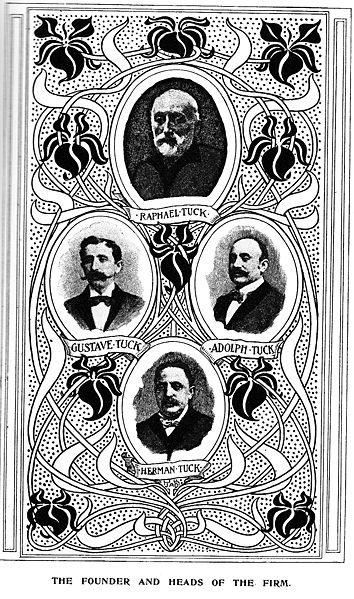 Image of Raphael Tuck and his sons (Raphael Tuck & Sons, Public domain, via Wikimedia Commons) Image of Raphael Tuck and his sons (Raphael Tuck & Sons, Public domain, via Wikimedia Commons)
Prior to the 1895 competition, Adolph had offered compensation to the renowned British poet Alfred, Lord Tennyson to write twelve verses of eight lines to be used in Tuck’s cards. Tennyson, who was then 80 years old and in poor health, reluctantly declined the offer. But Tennyson’s response to the offer shows the reputation of the company. He wrote, “You cannot imagine with what regret I have forfeited this opportunity of world-wide fame, for, beyond a doubt, these verses would have found their way into many far corners of the earth where I cannot flatter myself even my name is known.”
Adolph continued to expand the production of the company. In addition to greeting cards Raphael Tuck & Sons added calendars, books, wall texts and scripture mottoes, reproductions, relief and art novelties, postcards, and publications for children described as “designed to please and instruct the young.”
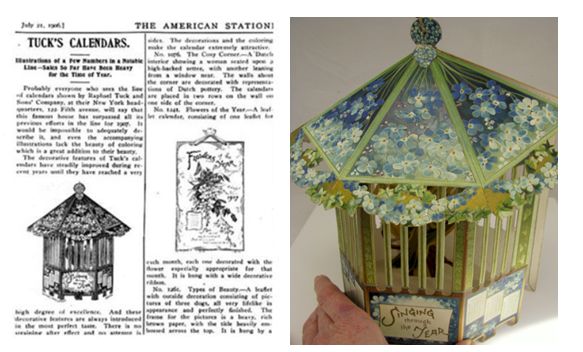
Tuck Calendar Images from the July 1906 edition of American Stationer and the collection of vintagepopupbooks.com
The 1906 ad
above states:
No. 1070. Singing Through the Year. A novelty calendar, consisting of
the representation of a bird cage with birds inside. The cage is
six-sided, and the calendars are upon four of the six sides. The decorations
and coloring make the calendar extremely attractive.
Adolph gave special attention to picture postcards. The first was issued in 1894 with a small picture of Mount Snowdon in the upper left corner. He arranged for the postcards to be sold by mountain guides on the Welsh mountain but postal regulations required that one side of the postcard be devoted to the address and that the other side have adequate room for a message. Thus there was only room for a small picture. Adolph negotiated for four years with the British Postmaster General to get permission to print a picture completely filling up one side of the card. That decision created a whole new picture postcard industry. Many of Tuck’s cards were printed using a technique called “oleography” and were called “Oilettes.” Oleography is a type of chromolithograph with an impressed grain pressed into the paint to add texture. In the finishing process the print is varnished in order to make it look like an oil painting. It is estimated that Tuck produced at least 12,000 to Tuck scrap sheet 15,000 different Oilette cards. And, overall, by 1900, the firm was offering for sale 40,000 different picture post cards.
Trade Cards -
Trade cards were very popular in the 19th century. Much like 20th century baseball cards, they were inserted into products as a way of enticing buyers into purchasing more of the product with the opportunity to collect the full set of cards. An example is a Cinderella a die-cut trading card produced for Panama Coffee from Chicago’s Franklin Mac Veach & Co. The card was embossed on both the front and the back. The text, on the back, indicates this set included a total of thirty-six picture cards in six sets with one picture in each package.
This brief look at Tucks’s card production does not include any of the puzzle postcards, puzzle books, or phonograph post cards, also issued early in the 20th century. Nor does this paper include any of Tuck’s paper dolls, an important part of the product line. The first of their paper dolls was patented in 1893; they are well documented and reproduced in several books that are listed in the bibliography.
Scrap -
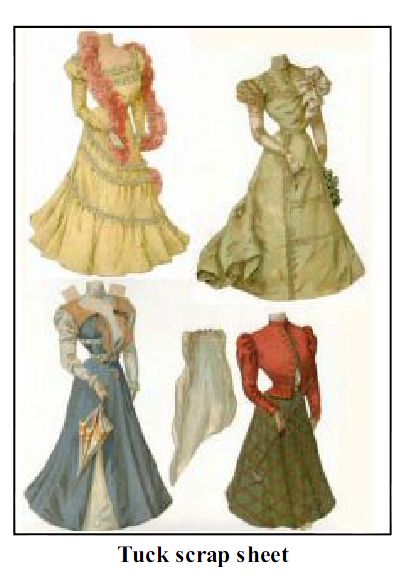
Scrapbooks were also popular in the late 19th century. Scrap was printed
and sold in sheets; many embossed and varnished to give them a glossy
surface. They were used in a variety of ways: decorations for handmade
cards and gifts, glued to fancy boxes (much like decoupage), and added
to screens which were often used during Victorian times as room
dividers. However, one of the most popular ways to use scrap was simply
to
paste it into scrapbooks. Some scrapbooks were made from blank books
while others were made by pasting over pages of catalogs, account books,
and notebooks. Often pressed flowers, tassels, and ticket stubs were
added to pages along with other collectibles. They reached their height
of popularity in the 1880s
and 1890s.
Ernestine died in 1885 and Raphael’s health began to fail. On April 4, 1898 he laid the foundation stone for a magnificent new building where all the business would be concentrated. The new building was called “Raphael House” and was opened June 6 1 899. Just one year later Raphael Tuck died at age 79.
In 1901 Raphael Tuck & Sons became a public company and the Board of Directorsconsisted of Adolph, Gustave, and Herman Tuck, Arthur Conan Doyle, and one other member.Following the pattern of their parents, Reginald and Desmond, sons of Adolph and Jeannette Tuck,joined the company. In 1910 Adolph Tuck was created a Baronet of the United Kingdom and wasknown thereafter as Sir Adolph Tuck.
At the start of World War I, Reginald Tuck joined the army. His brother Desmondvolunteered for overseas service. The onset of World War I effected the company in anothersignificant way. The reports in contemporary publications about Raphael Tuck & Sons further the understanding of what happened to them and other English-language publishers doing business in Germany at the start of the first World War. It was reported at the time that the branch of their business “established by the firm in Berlin in 1907, for the sale of their Oilette postcards and other British publications has been seized, and the business and assets sold by the German authorities.”
The report in the company history reads: “It appears that soon after the outbreak of the war this Berlin branch of Raphael Tuck & Sons, which was very profitable with large sums being due to the company at the time from customers throughout Germany and Austria, was taken over by the German Government. Shortly afterwards violent attacks directed against Raphael Tuck & Sons appeared in a leading Berlin journal, calling upon the German public to boycott the production of the well-known British publisher. Similar articles were published in some 200 journals throughout the German Empire. These attacks finally culminated in the business being taken over by the authorities. Raphael Tuck & Sons, in their official reply, intimated that they would naturally look for the intervention of His Majesty’s government with regard to the takeover of their property at the conclusion of the war.”
Following the war Reginald and Desmond returned to the family business. In 1926 Sir Adolph Tuck died. The 1929 depression affected the Raphael Tuck & Sons but by the end of the next decade the company’s financial position gradually improved. On December 29, 1940 London was bombed and the company offices at Raphael House, were completely destroyed. Within the cornerstone of the building, which had been laid 42 years earlier by Raphael Tuck, was found a broken glass jar and its undamaged contents: a catalog of the oldest Tuck products, a booklet with the results of the 1894 literary and painting competition, an April 5, 1898 issue of the Times and the Daily Telegraph, some greeting cards and periodicals and Adolph Tuck’s hand written company history up to l898. The company had to be rebuilt, like many other companies, during difficult war conditions and with a shortage of materials.
After the war many former employees came back, and the company survived. Sir Reginald died in 1954 and his son Bruce inherited the title of baronet but soon left the company. Desmond Tuck was the last Tuck in the company. He stimulated the company with all his flair and energy but, after he retired in 1959, the company changed hands several times. In 1962 Purnell & Sons Ltd. acquired Raphael Tuck & Sons and the final movable book with the Tuck imprint was issued in the 1952.
Tuck’s Books
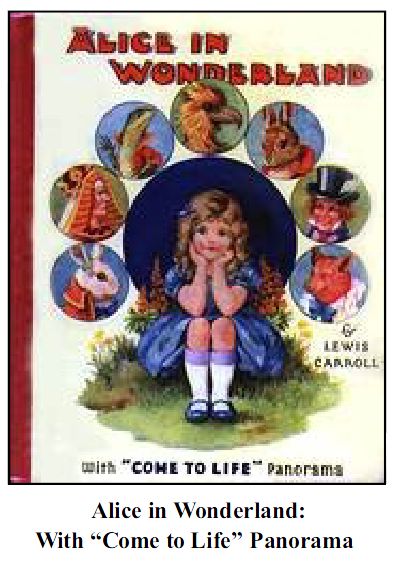
The total number of books (of all types) produced by Raphael Tuck & Sons is not known. In fact, the official company history does not even mention that they produced books. The two large international bibliographic databases that together record over 50 million cataloged books in libraries and museums worldwide, the Research Libraries Group Union Catalog and OCLC WorldCat, list over 500 titles published by Tuck, primarily flat books, but the number could very well have been hundreds more. .
Unlike their paper dolls and postcards, the history of Tuck’s illustrated books does not appear to have been documented. Tuck’s late 19th century and early 20th century books appeal to collectors primarily because of their beautiful chromolithographed illustrations. Published for both adults and children, the Tuck titles include books of sentiments, Bible stories, poems, small gift books, books with shaped covers, and stories printed on “untearable linen” as well as movable books.
Panorama Books
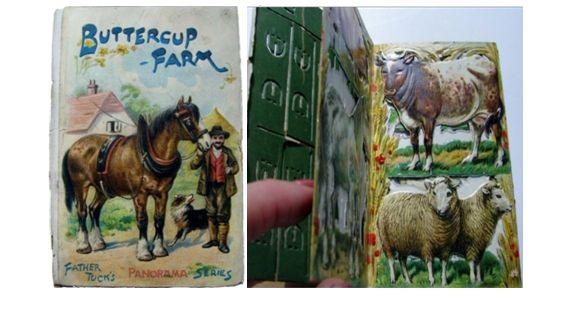
Buttercup Farm Father Tuck’s “Panorama” Series. [1900]. (above), from the collection of vintagepopupbooks.com
It is possible to document almost 100 movable books produced by Raphael Tuck & Sons from the late 19th century through the last quarter of the 20th century. Nearly thirty of those titles are panoramas based on a design Tuck first produced in the 1890s. Days in Catland with Louis Wain (ca. 1895) is typical of the four-panel panoramas that fold out to form a scene. A pocket in the back cover holds fourteen die-cut, numbered characters that can be inserted into numbered slots in the panorama to complete the picture. The extended tab on the front cover slips into a slot on the back cover to seal the pocket. Tuck was not consistent in the use of the term “panorama.” It was used to describe books like those described above as well as some with pop-up pictures such as Alice in Wonderland: With “Come to Life” Panorama which has pop-up plates. Most of the panoramas included fewer than twenty characters but at least two, produced in the 1950s, included as many fifty pieces. In some cases the characters were designed to stand up near, not in, the panorama. An unusual example is a book published
specifically for a single market. Little Red Riding Hood, part of “Father Tuck’s ‘Panorama’ Series,” included stand-up characters. The book was produced in Germany in about 1908 for the Baltimore, Maryland department store Hutzler Brothers. The book is not dated but, according to the company history, 1908 is the year the store began using the form of the name that appears on the cover of the book. The final page of the book has three die-cut, embossed sheets of punch-out figures. It is not known if another version was published.
Movable Books
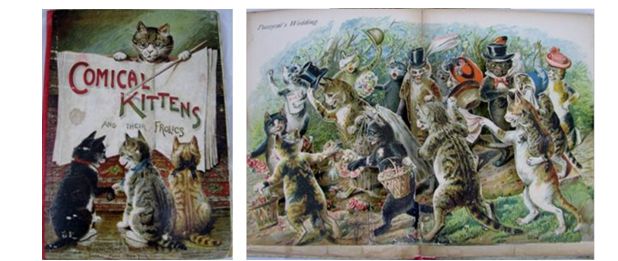
Comical Kittens And Their Frolics (above), "pop-up style" book from the collection of vintagepopupbooks.com
Tuck’s books with pop-ups date from about the 1890s. While interesting and attractive books, they lacked the sophisticated and unusual mechanicals found in the contemporary books illustrated by Lothar Meggendorfer or published by Ernest Nister. Some of Tuck’s books, like Fun for Little Folks and In Father Tuck’s Playroom and had plates that folded down to form a threedimensionals cene. Others had simple, layered pop-ups that pulled into place with the turn of a page, and yet others included tab-operated mechanicals. (When known, the mechanicals used in individual titles are described in the bibliography.)
The movable in A Very Good Book [1897] has not been found described in any other Tuck title. It is an ABC book and half of the letters of the alphabet are illustrated with sliding illustrations.The pages with these tab-operated illustrations have four letters per page and each pair of letters has a square box cut out under the letter. For instance, the letters P and Q initially display showing a pail. Then when the tab at the bottom of the page is moved, the illustration in the box becomes a quail. It is very simple; a single piece of paper slides up and down and the alternate pictures display in the die-cut box.
Seaside Pleasures (1896), with six layers of illustrations, forms a diorama-like scene. A centennial edition entitled Am Meeresstrand was reproduced by J.F. Schreiber in the mid-1980s with a new cover and supplemental text by Hildegarde Krahe. Tuck’s “Storyland Treasury” series included Alice in Wonderland, Fairy Tale Adventures, Sea Stories and Other Stories, Stories from Dickens, and Told by the Animals. (The verso of the title page of Stories from Dickens identifies “eight volumes uniform in size and price” as part of this series. The other titles are The Arabian Nights, Robinson Crusoe, and The Water Babies. None of those titles have been examined and the catalog records do not include the series designation in the record.) Each of the books has about 150 pages with one pop-up. They are not dated but were probably published in the 1920s or 1930s.
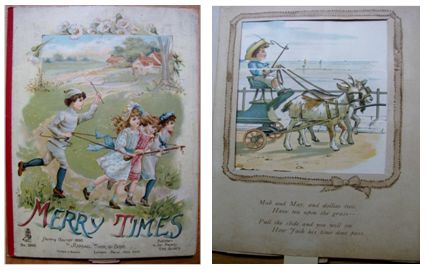
Merry Times by Raphael Tuck - Merry Times. 1895. “transformational slat plates” From the collection of vintagepopupbooks.com
Documenting Father Tuck’s Annuals would not have been possible without the assistance of Theo Gielen and I thank him for the time he spent with me in email correspondence answering questions, filling in details, and sending pictures.
The series Father Tuck’s Annual began about 1899 as compilations of illustrated stories, poems, games, and music. The earliest of the volumes did not include pop-ups. In the 1930s the annual was renamed Father Tuck’s Annual for Little People with “Come to Life” Pictures. Four books were published with that title, each including two pop-ups. With volume 34, published about 1932, the series was renamed yet again. This time it became Tuck’s Annual with Realistic Surprise Panoramas and four books were issued before the series ceased publication.
I’ll Tell You a Story is another pop-up book from the 1930s that has a brightly colored coverand includes one pop-up called “Fine Fun on the Sands.” Like the illustrations in the annuals, thepop-up is in full color while the background is printed in black with only one other color.
Since few Tuck books have publications dates, it is difficult to accurately date them but it appears there were few pop-ups produced from the mid-1930s until the 1950s. In l949 and 1950 Tuck published six books with illustrations and tab-operated mechanicals created by Julian Wehr. However, none of these books have Wehr’s name on the cover nor anywhereelse in the book. Not all of the U.S. editions credit Wehr on the cover but his name usually is listedin the copyright statement.
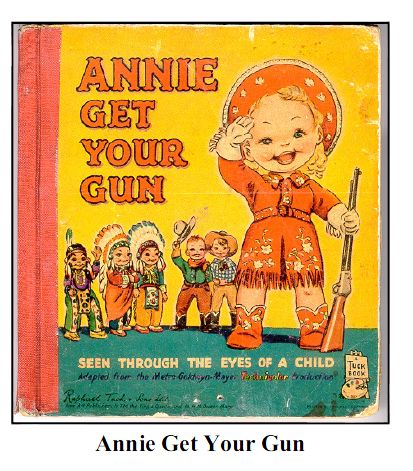
Annie Get Your Gun: Seen Through the Eyes of a Child was published in the early 1950s as Annie Get Your Gun
a movie tie-in. It is 6-inches by 6½ -inches and has four simple,fan-folded pop-ups.The final eight pop-up books published by Tuck wereissued in 1952. The books in the series A Father Tuck“Come-to-Life” Little Book were small, 4-inches by 4½-inches, and each had two fan-folded pop-ups. The books in this series, as well as Annie Get Your Gun were illustrated by Dinah. Raphael Tuck & Sons was a major publishing company for over a century and made significant contributions with their postcards, greeting cards, and books.
Extra Note added to this site by Vintagepopupbooks.com :
In 1907 Raphael Tuck established a branch in Mexico City, Mexico. At that time they were already located in London, New York, Paris, Berlin, and Montreal. (From
Geyer's Stationer: Devoted to the
Interests of the Stationery, Fancy Goods and Notion Trades, Volume 43 page 39 - 1907)
Authors Notes:
1. Raphael Tuck & Sons Ltd., The Romance of the House of Raphael Tuck & Sons Ltd Published on
the Occasion of the Company's Centenary. October, 1966. Page e (as reproduced in Paper Dolls and
Paper Toys of Raphael Tuck & Sons by Barbara Whitton Jendrick
2. http://www.mspong.org/cyclopedia/lithography.html March 20, 2005.
3. http://www.artoftheprint.com/artistpages/raphael_ tuck_and_sons_welshcorgi.htm. March 30,
2005.
4. Raphael Tuck & Sons Ltd., The Romance of the House... Page f.
5. Raphael Tuck & Sons. Raphael House. Raphael Tuck & Sons, 1899. Page 8.
6. Raphael Tuck & Sons Ltd., The Romance of the House... Page f.
7. Raphael Tuck & Sons. Raphael House. Page 12.
8. Raphael Tuck & Sons Ltd., The Romance of the House... Page g.
9. http://library.duke.edu/rubenstein/scriptorium/eaa/scrapbooks.html March 29, 2005.
10. Raphael Tuck & Sons Ltd., The Romance of the House... Page g.
11. Ibid. Page h.
12. Whitton, Blair and Margaret. Collector’s Guide to Raphael Tuck & Sons. Cumberland,
Maryland, Hobby House, Press, 1991. p. 139.
13. Raphael Tuck & Sons Ltd., The Romance of the House... Page j.
Title list of Movable Books by Raphael Tuck
Compiled by Ann Montanaro
May, 2005
Note: Unless otherwise specified, the following bibliographic descriptions come from the catalog
records supplied by one or more of the owning institutions. If no institution follows the citation, the
title is not listed in OCLC WorldCat or the RLG Union Catalog, databases of library and museum
holdings, each recording over 45 million titles.
Ali Baba and the Forty- Thieves: With “Come to Life” Pictures. Father Tuck “Come-to-Life” Little
Books Series. 1952. (British Library; University of Virginia).
Alice in Wonderland: With “Come to Life” Panorama. Storyland Treasury. Ada Bowley, illustrator.
[1932]. 7¾ "x 9¾ ". One pop-up. (University of California, Los Angeles).
Am Meeresstrand: Nach einem lOO Jahre alien Stehaufbilderbuch. Germany, J.F. Schreiber,
pubklisher. n.d (1986?). 22 x 30 cm. Reproduction of Seaside Pleasures with 20th century
illustrations by Milada Krautmann and text by Hildegarde Krahe.
Annie Get Your Gun: Seen Through the Eyes of a Child, Adapted from the Metro-Goldwyn-Mayer
Technicolor Production. [1950]. Four pop-ups. (British Library).
Arabian Nights Stories with “Come to Life” Panorama. Illustrated by H. G. Theaker and others.
[1920-1930]. 156 pages. “One double-spread pop-up.” Bookseller’s Description.
Behind the Curtain in Fairyland. [1891]. “Five panel panorama with pop-up pictures.” Bookseller’s
Description.
Christopher: With “Come to Life” Pictures. Father Tuck “Come-to-Life” Little Books Series. 1952.
Two pop-ups. (British Library).
Cinderella: With “Come to Life” Pictures. Father Tuck “Come-to-Life” Little Books Series. 1952.
(British Library; Western Michigan University).
Comical Kittens and their Frolics. 1896. “Two movable plates.”(Boston University, Yale
University).
Cosy Cot Farm with Pictures and Verses the Children to Charm. [1895]. Two double-page pop-ups.
(San Francisco State University).
Country Life. 1896. “6 tier color litho dimensional scene.” Bookseller’s description.
Days of Delight. 1896. http://www.ampersandbooks.co.uk/ August 18, 2004.
Dick Whittington: With “Come-to-Life” Pictures. Father Tuck “Come-to-Life” Little Books Series.
Dinah, illustrator. [1952]. 20 pages. Two double-page pop-ups. Bookseller’s description.
The Doll’s House. [1890]. “Six fold-out, stand-up pages illustrating five rooms in the doll’s house.”
(Osborne Collection, Toronto Public Library). Note:Vointagepopupbooks has also found an 1896
listing got this title in Raphael Tucks 1896 Holiday Catalog. This one may have had less scenes
but we don't know for sure.
Down on the Farm: With “Come to Life” Pictures. Father Tuck “Come-to-Life” Little Books Series.
1952. (British Library).
Fairy Tales Adventures: With “Come to Life” Panorama. Storyland Treasury. Illustrated by Molly
Benatar. M. and A. L. Bowley, et. al. [192-?]. 152 pages. “One double-page, color pop-out with all
the nursery characters.” Bookseller’s description.
Family Portraits. Father Tuck’s Mechanical Series. [189-?].Two tab-lifted illustrations. (Private
collection).
Father Tuck’s ABC Spelling Book. Father Tuck’s Little Lesson Series. [189-?]. Two double-page
pop-ups. (University of Florida).
Father Tuck’s Annual for Little People with “Come to Life” Pictures. London, Paris, New York, n.d.
265x195 mm. 111, (1) p. Cloth spine; cover illustration by Beatrice Mallet. Published between 1932
and 1934. Two pop-up illustrations: “Fine Fun on the Sands” and “The Animals went in Two by
Two.” First item: “Something very special.” Stories with b/w illustrations, two-tone illustrations in
blue, green, red or yellow, and four color plates. Information supplied by Theo Gielen.
Father Tuck’s Annual for Little People with “Come to Life”Pictures. London, Paris, New York, n.d.
265x195 mm. Cover illustration shows a boy wearing a red shirt and green hat, holding a dog, with
golf clubs visible over the boy’s shoulder. Includes two pop-up illustrations: an urban street scene
with people on horseback and an elephant with rider in the foreground and a second scene with toys,
dolls, and stuffed animals.
Father Tuck’s Annual for Little People with “Come to Life” Pictures. London, Paris, New York, n.d.
265x195 mm. 111, (1) p. Cloth spine; cover illustration of two children in clown costumes by
Beatrice Mallet. Published between 1932 and 1934. Two pop-up illustrations: “Birdland” and
“Nursery Rhyme Friends.” Stories with b/w illustrations, two-tone illustrations in blue, green, red
or yellow, and four color plates. Information supplied by Theo Gielen.
Father Tuck’s Annual for Little People with “Come to Life” Pictures. London, Paris, New York, n.d.
265x195 mm. 110, (1) p. Cloth spine; cover illustration by Beatrice Mallet featuring two children,
one riding on the back of the other, in a snowy scene with a snowman in the background. Published
between 1932 and 1934. Two pop-up illustrations: “At School in Catland” and “Life at the Farm.”
First item: “Many Happy Returns.” Stories with b/w illustrations, two-tone illustrations in blue,
green, red or yellow, and four color plates. Information supplied by Theo Gielen.
See also: Tuck’s Annual with Realistic Surprise Panoramas.
Father Tuck’s Book of Surprises. Father Tuck’s “Mechanical Series.” Printed in Bavaria. (Private
collection).
Father Tuck’s Fairy Tales. Father Tuck’s “Mechanical Series.” Printed in Bavaria. [1890], Four
tab-operated plates.
Father Tuck’s Holiday Hours. Father Tuck’s “Mechanical Series.” [192-?]. 4 pop-ups. (Private
collection).
Father Tuck’s Pets on the Farm ABC. [1900]. "With 4 chromolithographed movable plates with
levers." Bookseller's description.
Fireside Pictures. [1890]. “8 Moveables.” Bookseller’s description.
For Freedom! A Panoramic Picture Story Book of Our Navy-Army & Air Force. [194-?]. 3 pop-ups.
(Private collection).
Friends in the Country. Father Tuck’s Mechanical Series. [190-?]. 10 pages. Four tab-operated
mechanicals. Private collection.
Fun at the Circus. Combined Expanding Toy and Painting Book Series #608. [1892]. (Osborne
Collection, Toronto Public Library; University of California, Los Angeles; University of Florida;
University of North Texas).
Fun for Little Folks. Father Tuck’s Mechanical Series.[1890]. Pull-down plates. (Haining. Movable
Books, pp. 36-37).
The Gingerbread Boy: Animated Pictures. [Julian Wehr images and mechanicals without
attribution.] 1950. (British Library).
Granny’s Stories About Animals. Father Tuck's Mechanical Series. [1890]. “Four full-color movable
illustrations operated by levers.”(University of Florida).
In Father Tuck’s Playroom. [1900]. “Eight fold-down plates.” (Private collection).
I’ll Tell You a Story: With “Come to Life” Panorama. Come to Life Series. [193-?]. 8½" x 9 ½". 24
pages. One double-page pop-up. (Private collection).
Isn’t It Funny! 1895. “4 full-colour, movable illustrations operated by levers.” Bookseller’s
description.
Jack and the Beanstalk: Animated Pictures. [Julian Wehr images and mechanicals without
attribution.] 1950. (British Library; University of Oxford).
Jolly Companions. [1896]. Two double-page pop-ups showing “The Pleasures of Summer” and “The
Pleasures of Winter.” (Private collection).
Little Playmates at Work. Father Tuck’s Mechanical Series. Text by Clifton Bingham. Illustrated by
M. Bowley. [1917]. Bookseller’s description: “There are four full-page, full color,
three-dimensional, pull-down pop-ups which make into two separate planes of full color pictures to
complete the scene.”( Renier Collection).
Little Red Riding Hood. Artistic Series #605. [1900]. “Contains colored picture panels that when
pulled to one side pop-up to give a 3D appearance.” (Utah State University).
Little Red Riding Hood. The Combined Expanding Toy and Painting Book Series. 605. [1900].
(Kent State University; University of Florida).
Little Red Riding Hood: With "Come to Life " Pictures. Father Tuck’s “Come-to-Life” Little Books
Series. 1952. (British Library).
Little Red Riding Hood: Animated Pictures. By Julian Wehr. 1950. (British Library; Cotsen
Collection, Princeton University; University of Florida).
Merry Times. 1895. “Four transformational slat plates.” Bookseller’s description.
The Night Before Christmas: Animated Pictures. [Julian Wehr images without attribution.] 1950.
(British Library).
Nursery Rhymes: With “Come to Life” Pictures. Father Tuck’s “Come-to-Life” Little Books Series.
1952. Two fan-folded pop-ups. (British Library).
Old Nursery Friends. Father Tuck’s Mechanical Series. [1895]. Description from bookseller: “4
full-page, colour moveable illustrations, operated by levers.”
Our Friends at the Zoo. Combined Expanding Toy and Painting Book Series #609. [1900]. “Six
coloured plates with manually operated overlays which when raised from the page give depth to the
pictures.” (Osborne Collection, Toronto Public Library; University of Oxford).
Panoramic Pictures at the Zoo. No. 9910. [189-?]. Folding book: 21 x 162 cm. full size, folds to 21
x 27 cm. Panoramic design with each of the 6 panels having a pull-down plate. Each pull-down is
of an animal in a cage: lions, tigers, camels, zebras, deer, bears. (University of California, Los
Angeles).
Play and Pleasure. 1896. 12 pages 25 cm. “Children’s book with illustrations with movable tabs.”
(Glendale [California] Public Library).
Playtime Pictures: Pictures and Rhymes for Holiday Times. By Clifton Bingham. [1881-1895].
“Four pop-up illustrations printed in colour.” (Osborne Collection, Toronto Public Library).
Pleasure Pages. 1890. 9¾ " x 12". “Ten pages with four transformation pictures. 1st transformation:
petting donkey to picking wild flowers. 2nd transformation: picking blackberries to standing in
meadow. 3rd transformation: by the sea to picking wild flowers. 4th transformation: playing with
rabbits to sleeping in haystack” Bookseller’s description.
Puss in Boots: Animated Pictures . [Julian Wehr images and mechanicals without attribution.] 1950.
(British Library).
Robinson Crusoe. Father Tuck’s Mechanical Series. [1890]. "Four tab-operated color plates follow
Crusoe’s adventures." Bookseller's description.
Robinson Crusoe. The Combined Expanding Toy and Painting Book #604. [1893]. One large
double-page pop-up. (University of California, Los Angeles).
Robinson Crusoe:“With Come to Life Panorama.” By Defoe Daniel [abridged]. Illustrated by
Howard Davie and R. B. Ogle. [1932]. One double-page pop-up. Private collection.
Seaside Pleasures. 1896. “6 page diorama.” Bookseller’s description.
Sea Stories and Other Stories: “With come to life panorama.” By Major Charles Gilson, Natalie
Joan and others. Illustrated by C. E. Brock and T. Cuneo. [1930]. 160 pages. “‘Come to Life’
panorama is a card cut out of ships which stand out against the page.” (Buffalo & Erie County [New
York] Public Library). Bookseller's description.
Slovenly Peter. Father Tuck’s Mechanical Series. [189-?]. Horizontal tabs. (Haining, Movable
Books, pp.38-39).(University of Minnesota, Minneapolis).
Snow-White: With “Come to Life” Pictures. Father Tuck “Come-to-Life” Little Books Series. 1952.
(British Library).
Snow White: Animated Pictures. Animations by Julian Wehr. Duenwald Printing Corporation
copyright holder. 1949. (British Library; University of Florida).
Stories from Dickens for Boys and Girls: With “Come to Life” Panorama. The Storyland Treasury.
[193-?]. One double-page pop-up. (Boston University).
Summer Surprises. 1896. Two panoramic, peep-show-style pictures. (Haining, Movable Books, pp.
40-41. ).
The Three Kittens. The Combined Expanding Toy and Painting Book #607. [1900-?]. Private
collection.
Three Little Bears. The Combined Expanding Toy and Painting Book #606. [190-?]. (Osborne
Collection, Toronto Public Library).
To Market We Will Go. Father Tuck’s Mechanical Series. [189-?]. “Layered cut-out illustrations are
hinged to produce a three-dimensional effect.” (University of Delaware).
To Picture Land: Personally Conducted by Father Tuck. 1895. Two double-page pop-ups: “Friends
at the Farm” and “Seaside Pleasures.” (Boston University. University of California, Los Angeles).
Told by the Animals: With “Come to Life”Panorama. The Storyland Treasury. [192-?]. One pop-up.
(University of Virginia).
Tuck’s Annual with Realistic Surprise Panoramas. London. Paris. New York. Raphael Tuck & Sons
Ltd.. [1932]. 265x200 mm. 144, (1) p. Cloth spine; cover illustration by Molly Benatar. Three
pop-up illustrations: “Travels by train,” “By sea and air,” and “Fun at the circus.” Stories with b/w
illustrations and yellow: four color plates. Volume 34 of Tuck’s Annual, the first under its new name
(since 1899 they were Father Tuck’s Annual) and the first to contain pop-up panoramic models - as
the preface reads. Information supplied by Theo Gielen.
Tuck’s Annual with Realistic Surprise Panoramas. London, Paris, New York, Raphael Tuck & Sons
Ltd., [1933]. 265x200 mm. 144, (1) p. Cloth spine; cover illustration of a boy and a girl under an
umbrella in the snow, by Molly Benatar. Three pop-up illustrations: “The Joy of Motoring,”
“Changing Guard, Whitehall,” and “All the Fun of the Fair.” Volume 35 of the series. First story:
“This wonderful world.” Stories with b/w illustrations and yellow; four color plates. Information
supplied by Theo Gielen.
Tuck’s Annual with Realistic Surprise Panoramas. London, Paris, New York, Raphael Tuck & Sons
Ltd., [1934]. 265x195 mm. Ill, (1) p. Cloth spine; cover illustration of a boy and a girl sitting in a
carriage, by Molly Benatar. Two pop-up illustrations: “The Tower Bridge” and “Glorious Days of
Sport.” Volume 36 of the series. First story: “The Spirit of Progress.” Stories with b/w illustrations
and four color plates. Information supplied by Theo Gielen.
Tuck’s Annual with Realistic Surprise Panoramas. London, Paris, New York, Raphael Tuck & Sons
Ltd., [1935]. 265x195 mm. 1 11, (1) p. Cloth spine; cover illustration by Molly Benatar. Two pop-up
illustrations: “An Indian Durbar” and “The Tower of London.” The 37th and last volume of annuals
in the series. Stories with b/w illustrations and four color plates. Information supplied by Theo
Gielen. See also: Father Tuck’s Annual for Little People with “Come to Life” Pictures.
Under the Greenwood Tree. Father Tuck's Mechanical Series. [1900]. Bookseller's description: “A
six panel peepshow with intricate cut-outs showing a grand picnic in the woods.” Cataloging record:
“Three-dimensional color picture at back of book; in slipcase.” (Buffalo & Erie County [New York]
Public Library).
A Very Good Book. Father Tuck’s Mechanical Series. [1897]. “32 color lithograph illustrations on
8 tabs which are pulled to change the illustrations viewed through cut outs.”(Cotsen Collection,
Princeton University).
The Water Babies: With “Come to Life” Panorama. Come to Life Series. [192-?]. One double-page
pop-up. (Smithsonian Institution).
We’ve Tales to Tell: With “Come to Life” Panorama. Come to Life Series. [193-?]. One double-page
pop-up. (Private collection).
With Father Tuck in Playtime. Father Tuck’s Mechanical Series with Movable Figures. Text by
Clifton Bingham. Illustrations by M. Bowley. [1910]. “Four stand-up plates.”
http://www.ampersandbooks.co.uk/; August 18, 2004.
Panorama Books
Airport Scenic Panorama Book. n.d. [1955]. 12" x 10¼". “Includes more than 30 paper figures. Each
of the four panels is beautifully illustrated with chromolithographs. There are numbered slats into
which the reader inserts the corresponding figure to complete the airport scene and most are
interchangeable. Typical 50's style illustration and nice.” Bookseller’s description.
Alice in Wonderland Panorama with Movable Pictures. 1926. Description from Bookseller’s
catalog: “The rear cover has a pocket with a covering flap which houses 15 card figures of Alice and
the other Wonderland characters. The book folds out panorama style to reveal two pages of story and
black and white drawings on the same side as the covers. The reverse side is four pages of color
lithograph illustrations with 15 numbered slots to pop the 15 characters into.” (University of Illinois;
Princeton University).
The Army and Navy. [Between 1913 and 1925]. “Plates attached to both sides of four cardboard
panels, folded out to form a strip 23 x 73 cm. Army uniforms are on one side, navy uniforms on the
other.” (Osborne Collection. Toronto Public Library).
The Busy Seaport Scenic Panorama Book. Ellis Silas, illustrator, [mid 20th century]. “With Picture
Models of Ships etc. for arranging in position. Pictorial card wraps, unfolds to show 4 scenes.”
Bookseller’s description.
The Busy Seaport Scenic Panorama Book. Published by B. Shackman & Co., Inc. (distributor), New
York, 1999. “4-panel panoramic fold-out of an early 1900s port. You create a vibrant water scene
by placing numerous ships, bouys, cranes, etc. into the panorama. This is done by inserting tabs on
the ships, etc. into slots on the fold-out. A charming facsimile of a bygone day.” Bookseller’s
description.
The Busy Seaport Scenic Panorama Book: With Picture Models of Ships, etc., For Arranging in
Position. n.d., [ca. 1952]. Date of publication suggested by the Bodleian Library. Reproduction of
original in the Bodleian Library.
Buttercup Farm. Father Tuck’s “Panorama” Series. [1900]. 3½"x5". “Embossed chromolithographed
card cover, concertina folded chromolithographed sheet with die-cut figures of animals and stands.
Four pages of text about farm animals, five pages of fold-out, colorful, glossy stiff animal figures,
with two animals on each page.” Bookseller’s description.
Edited by vintagepopupbooks 10/24/20 :
With Father Tuck At The Seaside [ca. 1910]
Dutch version: "Zomervacantie aan zee" [ ca. 1912] Hildebrandt, M. (ed.). Zomervacantie aan zee. Amst.,
Scheltens & Giltay, n.d. (1912),
Notes on Dutch
language edition: From The Library of the Netherlands: The Author was
from the Netherlands. Alida Maria Hildebrandt started publishing
children's books around 1902. She was especcialy known for her
translations/adaptations of foreign children's books. Her only movable a
panorama book, entitled Zomervacantie aan zee (1912) and comes from
English. They list it as Summer holiday by the sea. Amsterdam, Scheltens
& Giltay, [1912]. (Panorama Series II)
Coronation Procession Panorama with Movable Pictures. [1952]. 10" x 12". “A four-fold book,
printed on heavy paper, colour illustrated background, with many cut-out coloured models to be
inserted into numbered slots along the route of the procession. Two sides of text describing the event
on reverse. Includes: Coach, Horses & Riders, Solders, Banners, Buckingham Palace & the Queen
Victoria Memorial etc.” Bookseller’s description.
Days in Catland with Louis Wain. Father Tuck’s Panorama. [1895]. 10" x l2 ½ ". “Featuring four
panels, each showing the interior of a different room in the cats' house with Wain's humanized cats
and furniture illustrated with chromolithographs. Throughout the panels there are 14 numbered slots
into which the reader inserts the corresponding figure to complete the scene. There are 14 fabulous
color cat cut-outs by Wain showing this family of cats playing, eating, cooking, fighting etc., plus
there is an amazing chromolithographed cover.” Bookseller’s description. (Cotsen Collection,
Princeton University).
Days in Catland with Louis Wain. New York, Shackman & Co., 1991. Includes fourteen cut-out
figures of individual cats and groups of cats to place within the four scenes of the panorama.
Reproduction of the 19th century Days in Catland with Louis Wain. (Private collection)
A Day in the Forest: To Myrtle Grove Farm. 1895. “A book-like folding panorama containing three
double-page pop-ups.” Whitton. Cataloging record: “Six leaves (covers included) pasted together
as to open in a straight line, as well as a regular book; movable cut-out leaves, pasted to each larger
leaf, complete the scenes; smaller board (77 x 88 mm.) pasted on front cover reveals color scene
when lifted.” (Indiana University).
Father Tuck’s Alice in Wonderland. New York, Shackman & Co., 2000. Reproduction of Father
Tuck’s Alice in Wonderland, Panorama. (University of Southern California).
Father Tuck’s Alice in Wonderland, Panorama. [1900?]. “Folded mounted pages.” (Cleveland
[Ohio] Public Library; University of Virginia).
Father Tuck’s Express Train Panorama. [1890?]. http://www.ampersandbooks.co.uk/; August 18,
2004,
Father Tuck’s Express Train Panorama With Movable Pictures. New York, Shackman & Co., 1995.
Includes 15 cut-out figures - passengers, workers, train parts - to be displayed within the 4 scenes
of the panorama. Reproduction of Father Tuck's Express Train Panorama. (Private collection)
Father Tuck’s Meadowsweet Farm. n.d. “Panorama book opening out to show four full-colour
scenes in which you can place the 15 farm animals and figures. These are contained in envelope at
the back of the book.” Bookseller’s description.
Father Tuck’s Noah 's Ark Panorama. New York, Shackman & Co., 1997. Includes fifteen cut-out
pairs of animals place within the four scenes of the panorama. Reproduction of Father Tuck 's Noah
's Ark Panorama With Moveable Pictures. (Private collection)
Father Tuck’s Noah 's Ark Panorama With Moveable Pictures. [ca. 1900]. “[4] pp. chromolith pp.
26.6 x 30 cm. chromolith bds. 15 chromolith animal pairs on stubs.” (Cotsen Collection, Princeton
University)
Father Tuck‘s Nursery Rhyme Panorama with Movable Pictures. “Ca. 1910. 14 characters to insert
in slots.” Bookseller's description.
Father Tuck’s World’s Circus Panorama with Movable Pictures. New York. Shackman & Co.,
1998. Includes fourteen different die-cut pieces to arrange within the four scenes of the panorama.
Reproduction of World's Circus Panorama with Movable Pictures. (Private collection).
Feathered Friends. Father Tuck’s Panorama Series, n.d. 3½" x 5". “Illustrated color wrapper on
front. Back cover is a sheet of punch-out pieces to make the figures stand, four pages of text about
bird figures, five pages of fold-out glossy color stiff bird figures, two birds to each page.”
Bookseller’s description.
Fun at the Seaside Panorama Book. n.d. [1955]. l0½ " x 12". Illustrated by Dinah. “From the back
cover: ‘HOW TO MAKE UP THIS SCENIC PANORAMA. Unseal the flap above, and you will find
an envelope in which are a number [48] of cut-out models. These are for you to fit into their places
in the background of this Panorama to make up a fascinating, realistic scene. To guide you, each
cut-out model is numbered, and there are corresponding numbers by the slots in the background into
which the models are to be fitted. The Panorama can be opened out to stand firmly: or if closed it
forms a handsome book with a charming full-colour cover. When you have fixed the models in their
slots, bend them outwards, when a realistic THIRD DIMENSIONAL effect is produced.’”
Bookseller’s description.
Little Red Riding Hood. Father Tuck’s Panorama Series. [1908?]. At head of title: Hutzler Brothers
Co. “There are Five 3" by 5" color pages of Little Red Riding Hood paper doll-like cut-outs with a
page of cardboard pieces to act as bases or stands for the figures. There is a beautiful front cover that
has Hutzler Brothers Co., a Baltimore based Department Store, imprinted across the top edge. So
this was more than likely an advertising premium for the store.” Bookseller’s description.
Little Snow-White. Father Tuck’s Panorama Series. 1900. 3" x 4½". “Consisting of 1 page of
instructions and four pages of story, after which are attached five chromolithographed panels of
paper doll figures folded accordion style and opening to 15". Also included is 1 page of die-cut
stands that the reader uses to mount the figures on after cutting them out.” (Pennsylvania State
University).
RAF Fighter Station Scenic Panorama. “46 picture models of planes, etc. for arranging in position.
To give a three-dimensional effect.” Bookseller’s description.
Road Travel. Roland Towers, illustrator. [1950]. “Scenic panorama book with 51 picture models of
cars, figures, etc. for arranging in position to give a three-dimensional effect. Two double-page
spreads with slots for die-cut shaped figures to insert into the slots.” Bookseller’s description.
Royal Naval Review Scenic Panorama Review. n.d. “Four fold-out panorama with 44 picture models
of ships, etc. for arranging in position give three-dimensional effect. Printed in England.”
Bookseller’s description.
With Father Tuck at the Circus. Verses by Clifton Bingham. [1920-1930]. 10" x 12½ ". “Large
four-section panorama pictures four circus performances. Each section has four horizontal slits, each
of which accepts the base tab supporting a clown, a performer or a circus animal.” Whitton.
With Father Tuck at the Seaside. [1912]. “Four panels each measuring 12½-inches (totaling 50
inches). Contains 16 figures which can be interchanged to create different scenes.” Bookseller’s
description.
With Father Tuck in Fairyland. [1890]. “The pictures are made up by arranging the cut out figures
in different parts of the scenery.” (Cotsen Collection, Princeton University; University of California,
Los Angeles).
With Father Tuck in Fairyland Panorama. New York, Shackman & Co., [199-?]. Includes 15
different, numbered die-cut pieces to arrange within the 4 scenes of the panorama. Reproduction of
With Father Tuck in Fairyland. (Private collection)
World’s Circus Panorama with Movable Pictures. [1890?]. Panorama with figures. (No record found
for original edition reprinted by Shackman.)
Raphael Tuck & Sons References
The following references include information about Raphael Tuck & Sons and/or the paper products
produced by the company.
Carver, Sally S. The American Postcard Guide to Tuck. Brookline, Massachusetts, Carves Cards,
1976.
Haining, Peter. Movable Books: An Illustrated History. London, New English Library Limited, 1979.
Hannas, Linda. The Jigsaw Book. New York, Dial Press, 1981.
Jendrick, Barbara Whitton. Paper Dolls & Paper Toys of Raphael Tuck & Sons. Privately published,
1970.
Krebs, Marta K. Raphael Tuck “Belles” Paper Dolls in Full Color. Mineola, New York, Dover
Publications, 1990.
Krebs, Marta K. Raphael Tuck “Little Maids” Paper Dolls in Full Color. Mineola, New York,
Dover Publications, 1990.
Montanaro, Ann R. Pop-up and Movable Books: A Bibliography. Metuchen, New Jersey, The
Scarecrow Press, 1993.
Montanaro, Ann R. Pop-up and Movable Books: A Bibliography. Supplement 1. 1991 - 1997.
Lantham, Maryland, The Scarecrow Press, 2000.
Opie, Iona and Peter. Opie Collection of Children’s Literature. Ann Arbor, Michigan, UMI, 1990-.
[161 Microfiche. Many Tuck books are included in this microfiche collection.]
Opie, Iona and Peter. The Opie Collection of Children’s Literature: A Guide to the Microfiche
Collection. Ann Arbor, Michigan, 1990-.
Raphael Tuck & Sons. Raphael House. London, Raphael Tuck & Sons, 1899.
Raphael Tuck & Sons. The Romance of the House of Raphael Tuck & Sons Ltd: Published on the
Occasion of the Company’s Centenary. London, Raphael Tuck & Sons, 1966. [As reproduced in
Jendrick’s Paper Dolls and Paper Toys of Raphael Tuck & Sons.]
Sawin, Sylvia D. Raphael Tuck Antique Paper Dolls in Full Color: From the Collection of the
Children’s Museum, Boston, Massachusetts. Mineola. New York, Dover Publications, 1987.
Whitton, Blair and Margaret Whitton. Collector’s Guide to Raphael Tuck & Sons: Paper Dolls,
Paper Toys, & Children’s Books. Cumberland, Maryland: Hobby House Press, 1991
About the author - Ann Montanaro Staples
Ann Montanaro Staples is an avid pop-up book collector, researcher, and author. Hercollection of pop-up books, begun in 1986, currently numbers more than 4,500 individual titles.She is the founder of The Movable Book Society, a world-wide organization of 400 membersthat has been promoting pop-up books since 1993. Her major works are the: Pop-up andMovable Books: A Bibliography (Scarecrow Press, 1993) and Pop-up and Movable Books: A Bibliography, Supplement 1, 1991-1997 (Scarecrow Press, 2000). These two volumes, as well as
their online update, document the history and publication of English-language mechanical books. Recent bibliographic updates are available on the web site of The Movable Book Society at:http://movablebooksociety.org/.
Ann was one of the authors who contributed to The Movable Book Society’s publication A Celebration of Pop-up and Movable Books (2004). In 2010 she wrote the Portfolio Essay for Handmade Paper in Motion (Hand Papermaking). She was the co-author of The Practical Stepby- step Guide to Making Pop-ups & Novelty Cards (Lorenz Books, 2012). In 2013 Southwater will publish another of her books, co-authored with Trish Phillips: Creative Pop-Up: A History And Project Book: A Fascinating Introduction To Paper Engineering, With 50 Step-By-Step Folds And Projects.
Books from Ann’s collection have been exhibited at Rutgers University, New Brunswick, New Jersey (1996); HarperCollins Gallery, New York City (1997); Pratt Institute, Brooklyn, New York (1999); Westport Library, Westport, Connecticut (2001); Franklin Township Public Library, Franklin Township, New Jersey (2001); Sharon Arts Center, Sharon, New Hampshire (2002); Georgian Court University, Lakewood Township, New Jersey (2007); Smithsonian Institution, Washington, D.C. (2009); City Library, Salt Lake City, Utah (2012); Brandwine
River Museum, Chadds Ford, Pennsylvania (2012); and Dennos Museum Center, Traverse City,
Michigan (2014).
Before her retirement, Ann was a librarian at Rutgers: The State University of New Jersey, where she was Director of Information Technology. She now lives in Salt Lake City, Utah.
|
|
|